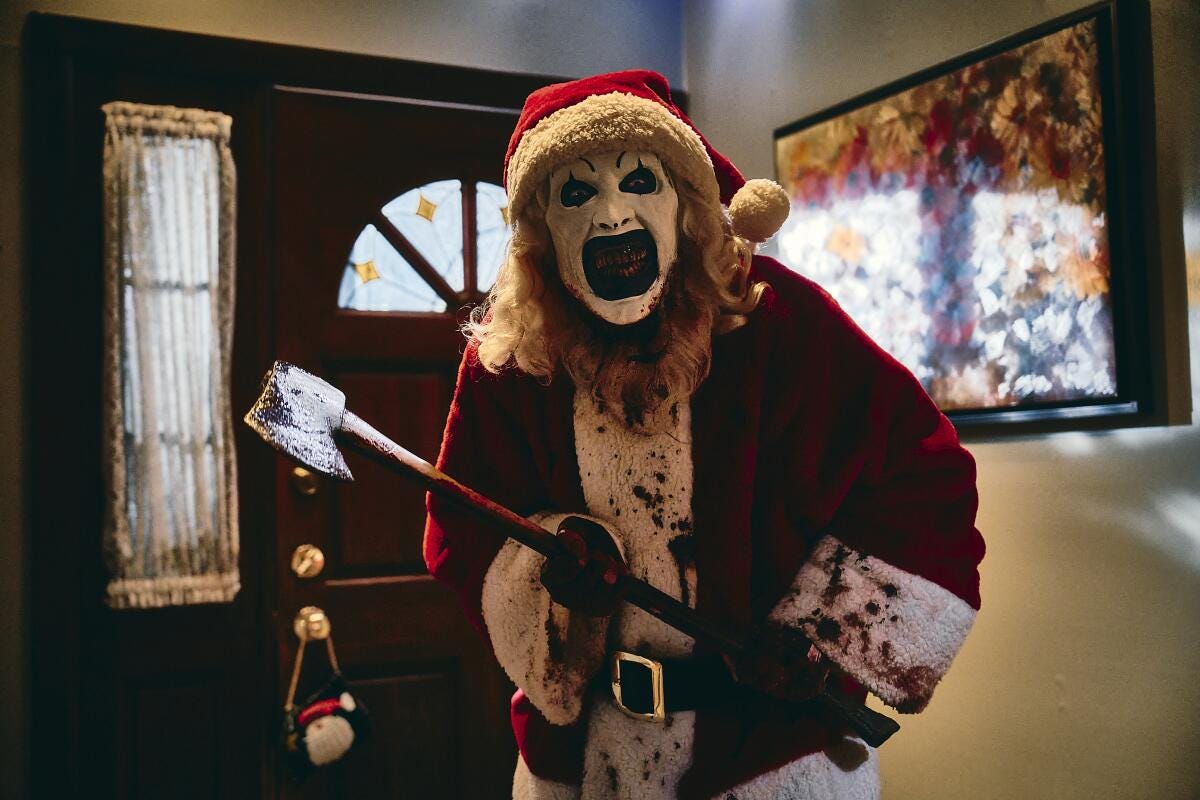The Sublime Insouciance of 'Terrifier 3'
Terrifier 3 is the latest masterclass in semiotics from the iconoclastic writer/director Damien Leone. Continuing his Homeric saga of good versus evil, Leone once again slyly subverts religious iconography, Jungian archetypes, and bourgeois cinematic grammar to deconstruct 21st-century socio-political anxieties and psycho-sexual mores. A droll satire and a savage polemic, Terrifier 3 is nothing short of spectacular.
With puckish wit, Leone intercalates Art the Clown - already a disquieting disruption of youthful naiveté - into a Yuletide scenario. Adorning Art in the accouterments of Santa Claus cements the vituperative harlequin’s import as a symbol of the demise of childhood innocence. Art denotatively deconstructs the American dream when he literally deconstructs little ones excited for the impending arrival of Jolly Saint Nick (lest we suspect Leone’s only interest is in exterminating infants, Art’s coitus interruptus of a perfectly Aryan Übermenschen couple similarly thwarts Judeo-Christian convention).
“You should worry more about your family’s safety,” a mother chides her husband after he leaves the front door to their home unlocked. Art inculcates her point when he massacres the husband in his sleep moments later. A prosopopoeia of our communal unconscious Todestrieb, Art is the ineluctable, looming threat of a truly ecclesiastical armageddon passed down from one generation to the next via a toxic amalgamation of trauma (epigenetic and first-hand alike) in concert with societal nihilism.
That Art himself takes childish glee in his bloodshed - and has a childlike regard for human fluids - is no mere coincidence (in one particularly waggish sequence, Art is overjoyed to meet a Santa impersonator; he later micturates on that impersonator’s lap, as, surely, many children have in the past). His joie de mort, magnificently rendered by David Howard Thornton, is a diseased counterbalance to the illusionary security of systemic praxis (having already desiccated Halloween and Christmas in the first three Terrifier pictures, I would not be surprised if the foreordained fourth entry sought to undermine the Fourth of July). Nothing and no one is safe from Art’s malice.
This is why transgressions against polite society’s so-called “good taste” are such a vital component of the Terrifier cycle. Form follows function: as Art eradicates the very concepts of justice and karma, so Leone must annihilate even the faintest adumbration of decorum. To conform to etiquette would be insincere to Art as a character and rob him of his weight as an avatar.
In Terrifier 2, Art’s counterpart, Sienna (Lauren LaVera), battled the malignant jester while dressed as an angelic Valkyrie; the visual metaphors utilized in T3 are even less subtle. Art repeatedly recreates Christ’s final crucible, afflicting his victims with stigmata, crucifying them against the walls of their homes. Only Sienna is resistant to this Pontius Prankster (Art wounds Sienna’s hands, and it does little to dampen her pugnaciousness). In a hallucinatory trance, Sienna sees the sword that she uses to combat Arther born of a demonic blacksmith leashed by a sentient statue that resembles the Virgin Mary, inverting the wisdom of Milton’s Paradise Lost (“Better to reign in Hell, then serve in Heav'n”); her ability to defeat Art, meanwhile, has been passed down to her from her father (i.e., The Creator). Care to wager that this chronicle will eventually conclude with Sienna dying for our sins?
Or perhaps that would be too on-the-nose; with her cousin now trapped in Hell, perhaps she will traverse the River Styx, and/or find herself a cog in a sinister retelling of Orpheus and Eurydice. Given Leone’s irreverent stance towards narrative custom, perhaps Art and his demonic benefactor will ultimately emerge victorious. That could be the most terrifying conclusion of all.



